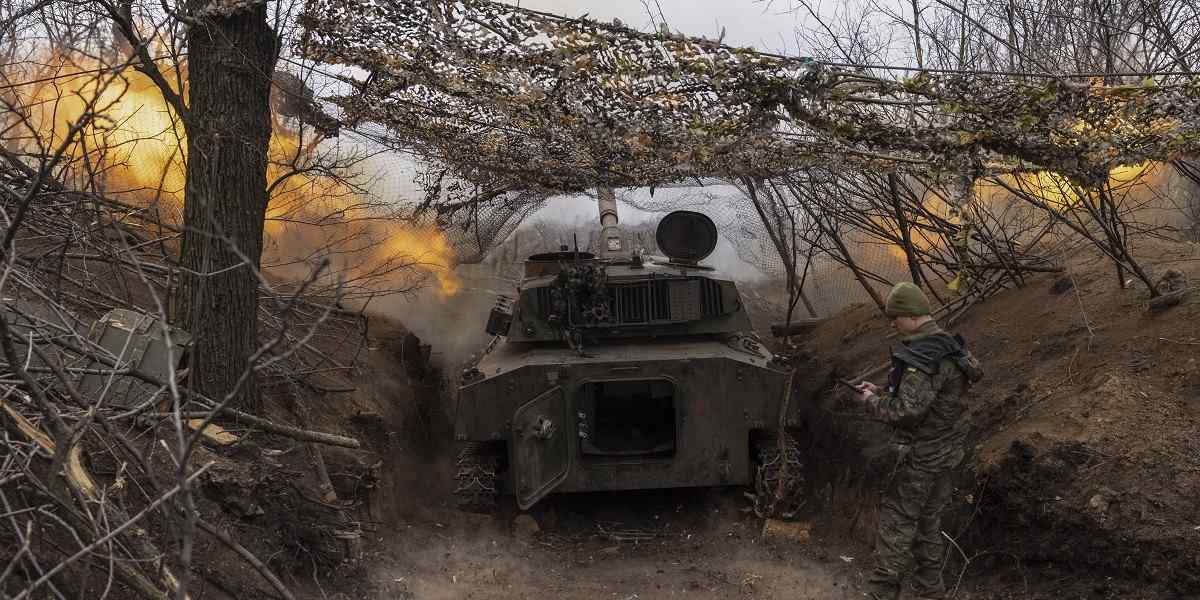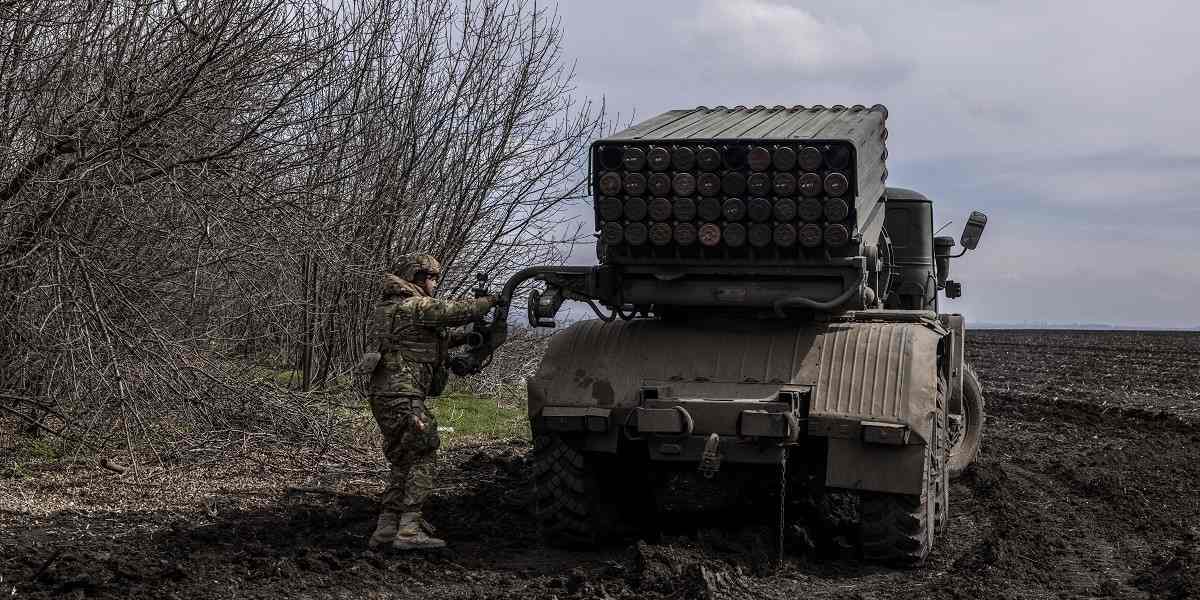
Some of the explosives are made using found Russian unexploded ordnance.
17:18 JST, April 9, 2023
DONETSK REGION, Ukraine – The artillery shells were stored in a shallow mud dugout, covered with a black plastic tarp to keep them safe. Just 14 rounds remained – evidence of a critical ammunition shortage that has the Ukrainians scrambling for ways to conserve supply until their Western allies can produce or procure more.
The artillery platoon, with the 59th Motorized Brigade in eastern Ukraine, used to fire more than 20 or 30 shells per day with their Soviet-era howitzer. Now, they typically shoot one or two, or none at all.
The ammunition that has pounded parts of Ukraine daily for more than a year has become a precious resource in the artillery war with Russia – and which side conserves shells and rearms faster could turn the tide on the battlefield.
In the dugout, a Ukrainian soldier reached for a round as his commander recited coordinates for their first shot of the day. “Fire,” yelled the commander, whom The Post agreed to identify by his call sign, Spider, due to the security risks. After the blast, he waited, staring at his phone for another order. He didn’t receive one, so he told his men to stand down, not knowing if the shell had hit its target or his commander just didn’t want to spend another one.
Even amid a shortage, Ukraine is firing some 7,700 shells per day, or roughly one every six seconds, according to a Ukrainian military official who spoke on the condition of anonymity as they were not authorized to speak publicly. Russia, which may also be running low, is firing more – by some estimates triple that amount.
To keep up with their adversary and still conserve ammunition, the Ukrainian military is now pickier in selecting targets, often prioritizing equipment over small groups of infantry. Precision is key because misses mean wasted shells. And in underground workshops across eastern Ukraine, soldiers are using 3D printers and recycling unexploded ordinances to create alternative munitions.
Artillery rounds for Ukraine’s Soviet-era guns, which make up the majority of their arsenal, have long been in short supply. That has forced a reliance on the artillery provided by Kyiv’s Western allies because they use 155mm caliber shells, which Ukraine has more of for now but for far fewer guns.
At the pace Ukraine is firing, those stocks could soon run out, too, as Western countries struggle to ramp up production. In February, NATO Secretary General Jens Stoltenberg warned that the “current rate of Ukraine’s ammunition expenditure is many times higher than our current rate of production.”
Nearby Spider’s artillery position, the thunder of a U.S.-provided M777 howitzer, with its 155mm shells, roared every few minutes while he and his men drank tea in a foxhole. “Sometimes we just sit here and listen to the M777 shooting and the Russian creatures shooting back. It’s like a talk between them,” Spider said.
“We don’t have a lot of ammunition, so that’s why we don’t work a lot,” he said.
The countries that still have stocks of Soviet-standard 152mm and 122mm rounds are largely former Soviet republics, many of which are hesitant to sell to Ukraine because of their ties with Russia. Some African and Middle Eastern countries, which have received weapons and ammunition from Russia over the years, also have stocks of those shells. A few former Warsaw Pact countries have the capacity to manufacture the shells but not at the scale and speed Ukraine needs on the battlefield.
Occasionally, a third country friendly to Ukraine will purchase the ammunition – sometimes through a broker – and then supply it to Ukraine in secret to avoid any political fallout for the seller. Often, the result is that one artillery piece on the battlefield may have shells produced in several countries, which soldiers say may not fire the same, affecting accuracy.

Ukrainian forces fire a 2S1 “Hvozdyka,” a Soviet-era 122mm self-propelled artillery installation, toward Russian positions.
“The main issue of concern is sustainability,” Ukrainian Foreign Minister Dmytro Kuleba said. “Former Warsaw Pact countries, they dismantled their production lines of Soviet-caliber ammunition since they became members of NATO. Now, we badly need this Soviet-caliber ammunition, so the question is how to restore production lines.”
Bulgaria has already agreed, as has Poland and Slovakia, according to Ukrainian Defense Ministry spokesman Yuriy Sak. But it’s unclear how long it will take for the needed shells to be produced and reach the battlefield.
In the meantime, the hunt for shells is occasionally perilous. In areas where Russian forces retreated, soldiers wade through mined fields and forest to look for abandoned ammunition. One such group, which was ferrying any shells to the 59th brigade, recently hit unexploded ordnance.
The 14 shells Spider’s platoon has left came from Russian stocks seized in the Kherson region in November. Spider said he didn’t know when he would get more.
The United States has searched worldwide to round up stockpiles of Soviet artillery rounds, but deliveries can take months. On Tuesday, as part of a larger security assistance package, the Pentagon said it would provide an unspecified number of artillery shells, including 122mm caliber rounds it does not produce itself. A workhorse Ukrainian artillery piece, the D-30, uses such rounds.
“We’re incredibly transparent with the Ukrainians, so they have a really good understanding of what ammunition we are planning to provide, when we are planning to provide it,” said a senior U.S. defense official, speaking to reporters on the condition of anonymity under ground rules set by the Pentagon. “So that enables them to be able to plan their operations and understand where they need to flow equipment.”

Ukrainian forces fire a 2S1 “Hvozdyka,” a Soviet-era 122mm self-propelled artillery installation, toward Russian positions.
The Ukrainians could be holding back some ammunition for a planned spring counteroffensive. Soldiers in the field said what they have now is just enough to repel daily assaults but not to counterattack.
Rob Lee, a military analyst at the Foreign Policy Research Institute, said that he suspects the United States and other Western backers have increased ammunition deliveries ahead of the spring offensive, but shipments could slow in fall and winter.
That raises the stakes for Ukraine to retake a lot of territory soon because a long war would probably favor Russia. U.S. officials have said that China is considering sending Russia 122mm and 152mm shells. Lee said that if that did happen, it “could significantly change the course of the war.”

Members of Ukrainian forces stand by artillery shells for a captured Soviet-era Russian 152mm howitzer in the Donetsk region in eastern Ukraine on March 28.
“This is ultimately an artillery war, so whichever side has more artillery rounds or can produce it more and sustain that long term is going to have a significant advantage,” Lee said. “Artillery ammunition availability is one of the most single important factors in this war.”
Russia is still firing more than Ukraine every day, but Ukrainian officials said they have noticed their enemy become increasingly conservative, a sign they may also be facing a shortage. In social media posts, Russian military bloggers and soldiers have complained about a lack of ammunition.
Col. Gen. Oleksandr Syrsky, Ukraine’s ground forces commander, said that Russian forces continue to fire heavily at priority locations on the front, but “where they are not attacking, they have restrictions on the use of artillery.”
“Due to this, they use tank fire from closed positions,” Syrsky said in February. “Tanks are actually used as substitutes for artillery systems.”
The Ukrainians have also explored creative conservation tactics. In some cases, crews bring unexploded ordinances originally fired by the Russians to secret labs in eastern Ukraine, and the elements are carefully stripped away to create a new munition.
Volunteers and soldiers work with 3D printers to fashion small, relatively inexpensive munitions that can be dropped from drones. Bullets are deconstructed. The ball bearings from a Claymore mine are removed and then used in a different anti-personnel or antitank mine. At one of these sites, there are shrapnel holes in the ceiling – the result of an explosion that occurred during the refashioning process. Two people died.
But while the homemade munitions can replace artillery to bomb an immobile tank, they’re not a substitute for pinning down forces during an offensive – or repelling an assault.
In an underground operations center for the 59th brigade in the Donetsk region, drone footage from 30 miles away played on four mounted monitors. It was a sky-high view of the town of Pervomaiske as it was under attack by Russian forces.
“Where infantry can work without artillery, only infantry works,” said an artillery chief in the room, whose call sign is Shaman. “If there is a small group of the enemy, it all depends on how small it is. If there are two or three people, we don’t fire on them, but if there are 10 or 15, we work. If they move to our positions, it will be an assault action. So then we also have to work – like now, for example.”
The live stream showed a village in ruins with homes reduced to rubble and the ground covered in dark craters – scars of a war that has used an astonishing amount of artillery. A plume of smoke rose over the landscape where another shell had just crashed.
Shaman passed another set of coordinates down to the soldiers operating the howitzers on the ground for the next wave of fire. The Ukrainians that day could use their 155mm rounds while saving their Soviet calibers. But how long would that last?
“At the beginning of the war, we were working to contain the enemy,” Shaman said. “Those were the toughest months, we were stopping them and our Soviet cannons wouldn’t shut up. We exhausted everything we had, but we stopped the enemy. Now, to go on the offensive, contain the enemy . . . we need more ammunition.”
"News Services" POPULAR ARTICLE
-

American Playwright Jeremy O. Harris Arrested in Japan on Alleged Drug Smuggling
-

Japan’s Nikkei Stock Average as JGB Yields, Yen Rise on Rate-Hike Bets
-

Japan’s Nikkei Stock Average Licks Wounds after Selloff Sparked by BOJ Hike Bets (UPDATE 1)
-

Japanese Bond Yields Zoom, Stocks Slide as Rate Hike Looms
-

Japan’s Nikkei Stock Average Buoyed by Stable Yen; SoftBank’s Slide Caps Gains (UPDATE 1)
JN ACCESS RANKING
-

Keidanren Chairman Yoshinobu Tsutsui Visits Kashiwazaki-Kariwa Nuclear Power Plant; Inspects New Emergency Safety System
-

Imports of Rare Earths from China Facing Delays, May Be Caused by Deterioration of Japan-China Relations
-

University of Tokyo Professor Discusses Japanese Economic Security in Interview Ahead of Forum
-

Japan Pulls out of Vietnam Nuclear Project, Complicating Hanoi’s Power Plans
-

Govt Aims to Expand NISA Program Lineup, Abolish Age Restriction



















